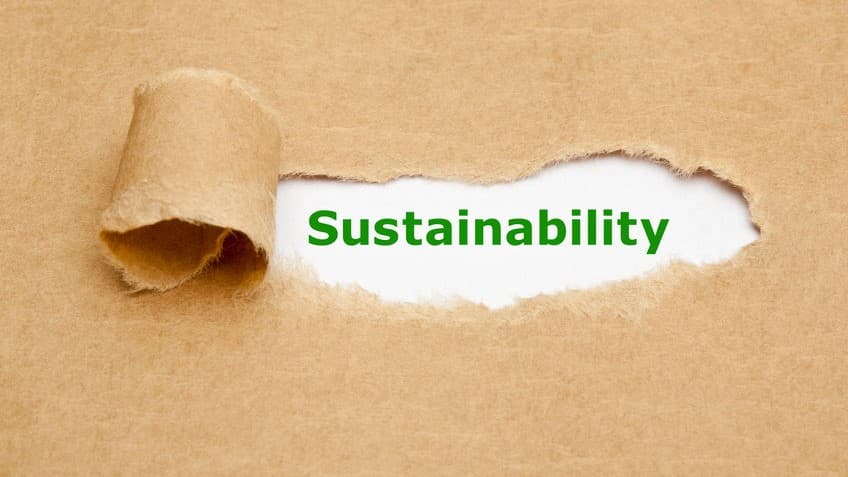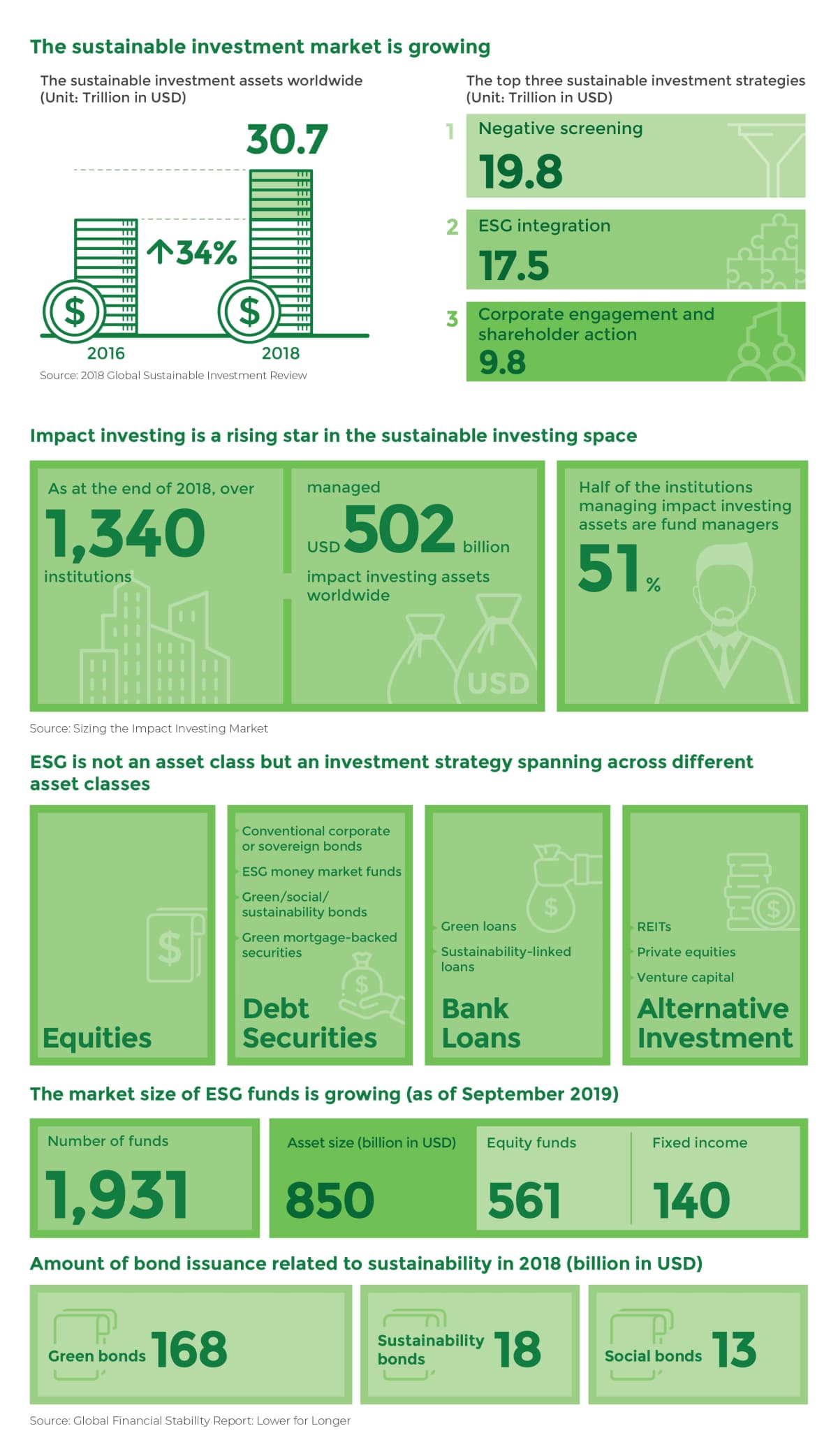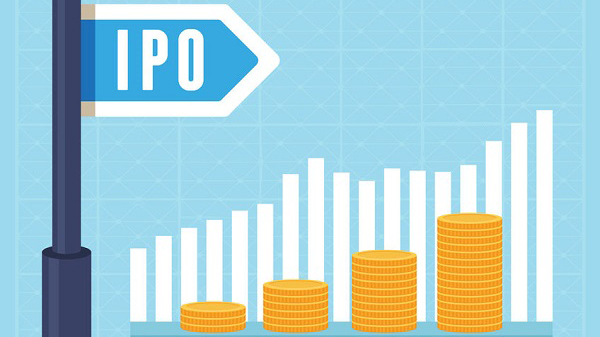New Perspectives on Investment:
ESG, Impact and Socially Responsible Investing

Should profits always come first in the financial market?
Are investments solely based on self-interests and focused on financial returns?
The most common view on the financial market is likely to be “yes”. In the world of investing, returns have always been the sole concern of investors, while other areas like environment and social issues are often underplayed.
However, the pressing issue of climate change can no longer be ignored. Gone are the days where you would assume that investing has nothing to do with the environment and society. Climate change and environmental challenges can present a company or an investment project with both growth opportunities and material risks. Today, the entire financial industry, including international organisations, regulatory bodies worldwide, practitioners and investors, have their eyes set on green finance or sustainable investing to effect positive environmental and social outcomes.
ESG (environmental, social and governance), impact and socially responsible investing, are among some of the most talked about sustainable investing concepts, advocating investors to invest “outside of the box”. While the three investment concepts have different focuses, they all seek to take into account non-financial considerations, including environmental and social factors, in the investment decision-making process to improve risk and return, while benefitting the environment and society.
Key Features of ESG, Impact and Socially Responsible Investing
The process of integrating non-financial factors into the existing investment process are crucial to sustainable investing. These considerations can play a role in funnelling investment opportunities or analysing the growth potential and risks of a company and investment project.
| ESG Investing |
|
|---|---|
| Impact Investing |
|
| Socially Responsible Investing |
|
ESG, impact and socially responsible investing all share the vision of bridging the gap between the financial market and the environment and society to deliver on certain environmental and social goals, such as tackling climate change or poverty, while creating attractive returns.
Emerging from the 1960s, socially responsible investing is typically regarded as the origin of green finance or sustainable investing. Over the years, sustainability has evolved from being on the side-line to becoming a type of mainstream investment. In the past, socially responsible investment is only an investment alternative considered by few investors, e.g. venture capital funds. Today, many investors, institutional and retail investors alike, take into account ESG factors as part of the investment decision making process. Both the number of sustainable financial and index-based products in the market, and the total asset under management (AUM) of sustainable or green funds worldwide are now on the rise.
Can we have the cake and eat it too?
Some investors find it hard to choose between investment returns and positive environmental and social impact. The question of whether one can enjoy both equally, or whether one needs to make a trade-off, has stirred much debates in the market.
Socially responsible investing adopts the strategy of negative screening by eliminating companies or sectors that do not have a positive environmental and societal impact. Many perceive this investment approach as exchanging returns for ethics, and that by imposing such restrictions it actually works against investment returns and risk diversification. However, does a narrower scope of investment inevitably undermine the returns and efficiency? There is still no conclusive answers after years of debate.
The purpose of incorporating ESG factors into investment analysis and the decision-making process is to improve the risk-return profile. According to the Global Financial Stability Report (GFSR) published by International Monetary Fund (IMF) in October 2019, the risk-return levels of sustainability funds are comparable to those of similar global equity funds. There is no evidence that sustainability funds outperform or underperform their peers. Meanwhile, impact investors are more accommodative when it comes to expected returns. According to the 2019 annual survey report published by Global Impact Investing Network (GIIN), over 60% of impact investors expected a return on par with market performance while the remaining accepted a return lower than the market level. However, most of them were able to meet or even exceed their targets in terms of the financial returns and environmental and social impact.
An index is an important tool to measure the performance of a market, industry or asset class. It is also a key investment benchmark. As green finance and sustainable investing are beginning to take centre stage, leading index providers like MSCI, FTSE Russell and S&P Dow Jones Indices have been actively devising relevant indices to give investors a clearer picture of the performance gap between sustainable investments and traditional investments. This trend also facilitates the development of sustainable or green index-based products.
Sustainable Investing Takes Root in Hong Kong
As green finance and sustainable investing become a global trend, they too have set foot in the Hong Kong investment scene. In 2018, the HKSAR Government launched the Government Green Bond Programme with a borrowing ceiling of $100 billion. Moreover, financial regulators and related authorities have implemented various initiatives, such as the Green Finance Certification Scheme, to support the local green finance market.
At present, retail investors may not be too familiar with green finance and sustainable investing, but this is about to change: Related financial products are coming online and listed companies are upping their ESG disclosures.
- ESG and green funds: There are now about 30 SFC-authorised green and ESG funds in the market. You may visit the SFC website for the offering documents and products key facts statements.
- ESG reports of listed companies: Listed companies are required to prepare ESG reports as regulators have, in recent years, been tightening the ESG governance and disclosure requirements of listed companies. While a company’s financial statement and management discussion and analysis provide information on its business and financial performance, the ESG report keeps investors informed of its ESG-related opportunities and risks. Commencing from 1 July 2020, listed companies are required to disclose significant climate-related matters which have impacted and may impact the company.
Climate change is now an important risk-return consideration, and there is no need to compromise on the returns as we pursue positive environmental and social impact. Investment gains, environmental protection and social responsibility can all have a role in today’s investment process.
16 July 2020





